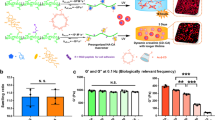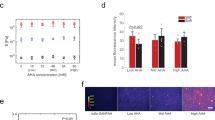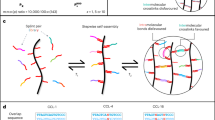Abstract
Bulk matrix stiffness has emerged as a key mechanical cue in stem cell differentiation. Here, we show that the commitment and differentiation of human mesenchymal stem cells encapsulated in physiologically soft (∼0.2–0.4 kPa), fully synthetic polyisocyanopeptide-based three-dimensional (3D) matrices that mimic the stiffness of adult stem cell niches and show biopolymer-like stress stiffening, can be readily switched from adipogenesis to osteogenesis by changing only the onset of stress stiffening. This mechanical behaviour can be tuned by simply altering the material’s polymer length whilst maintaining stiffness and ligand density. Our findings introduce stress stiffening as an important parameter that governs stem cell fate in a 3D microenvironment, and reveal a correlation between the onset of stiffening and the expression of the microtubule-associated protein DCAMKL1, thus implicating DCAMKL1 in a stress-stiffening-mediated, mechanotransduction pathway that involves microtubule dynamics in stem cell osteogenesis.
This is a preview of subscription content, access via your institution
Access options
Subscribe to this journal
Receive 12 print issues and online access
$259.00 per year
only $21.58 per issue
Buy this article
- Purchase on Springer Link
- Instant access to full article PDF
Prices may be subject to local taxes which are calculated during checkout




Similar content being viewed by others
References
Discher, D. E., Mooney, D. J. & Zandstra, P. W. Growth factors, matrices, and forces combine and control stem cells. Science 324, 1673–1677 (2009).
Discher, D. E., Janmey, P. & Wang, Y.-L. Tissue cells feel and respond to the stiffness of their substrate. Science 310, 1139–1143 (2005).
Baker, B. M. & Chen, C. S. Deconstructing the third dimension—how 3D culture microenvironments alter cellular cues. J. Cell Sci. 125, 3015–3024 (2012).
Eyckmans, J., Boudou, T., Yu, X. & Chen, C. S. A hitchhiker’s guide to mechanobiology. Dev. Cell 21, 35–47 (2011).
Das, R. K. & Zouani, O. F. A review of the effects of the cell environment physicochemical nanoarchitecture on stem cell commitment. Biomaterials 35, 5278–5293 (2014).
Vogel, V. & Sheetz, M. Local force and geometry sensing regulate cell functions. Nature Rev. Mol. Cell Biol. 7, 265–275 (2006).
Chaudhuri, O. et al. Extracellular matrix stiffness and composition jointly regulate the induction of malignant phenotypes in mammary epithelium. Nature Mater. 13, 970–978 (2014).
Wen, J. H. et al. Interplay of matrix stiffness and protein tethering in stem cell differentiation. Nature Mater. 13, 979–987 (2014).
McBeath, R., Pirone, D. M., Nelson, C. M., Bhadriraju, K. & Chen, C. S. Cell shape, cytoskeletal tension, and RhoA regulate stem cell lineage commitment. Dev. Cell 6, 483–495 (2004).
McNamara, L. E. et al. The role of microtopography in cellular mechanotransduction. Biomaterials 33, 2835–2847 (2012).
Nikukar, H. et al. Osteogenesis of mesenchymal stem cells by nanoscale mechanotransduction. ACS Nano 7, 2758–2767 (2013).
Zouani, O. F. et al. Altered nanofeature size dictates stem cell differentiation. J. Cell Sci. 125, 1217–1224 (2012).
Zouani, O. F., Kalisky, J., Ibarboure, E. & Durrieu, M. C. Effect of BMP-2 from matrices of different stiffnesses for the modulation of stem cell fate. Biomaterials 34, 2157–2166 (2013).
Das, R. K., Zouani, O. F., Labrugère, C., Oda, R. & Durrieu, M.-C. Influence of nanohelical shape and periodicity on stem cell fate. ACS Nano 7, 3351–3361 (2013).
Cheng, Z. A., Zouani, O. F., Glinel, K., Jonas, A. M. & Durrieu, M. C. Bioactive chemical nanopatterns impact human mesenchymal stem cell fate. Nano Lett. 13, 3923–3929 (2013).
Fu, J. et al. Mechanical regulation of cell function with geometrically modulated elastomeric substrates. Nature Methods 7, 733–736 (2010).
Engler, A. J., Sen, S., Sweeney, H. L. & Discher, D. E. Matrix elasticity directs stem cell lineage specification. Cell 126, 677–689 (2006).
Ingber, D. E. Mechanical signaling and the cellular response to extracellular matrix in angiogenesis and cardiovascular physiology. Circ. Res. 91, 877–887 (2002).
Huebsch, N. et al. Harnessing traction-mediated manipulation of the cell/matrix interface to control stem-cell fate. Nature Mater. 9, 518–526 (2010).
Khetan, S. et al. Degradation-mediated cellular traction directs stem cell fate in covalently crosslinked three-dimensional hydrogels. Nature Mater. 12, 458–465 (2013).
Houseman, B. T. & Mrksich, M. The microenvironment of immobilized Arg-Gly-Asp peptides is an important determinant of cell adhesion. Biomaterials 22, 943–955 (2001).
Keselowsky, B. G., Collard, D. M. & García, A. J. Integrin binding specificity regulates biomaterial surface chemistry effects on cell differentiation. Proc. Natl Acad. Sci. USA 102, 5953–5957 (2005).
Wen, J. H. et al. Interplay of matrix stiffness and protein tethering in stem cell differentiation. Nature Mater. 13, 979–987 (2014).
Van Buul, A. M. et al. Stiffness versus architecture of single helical polyisocyanopeptides. Chem. Sci. 4, 2357–2363 (2013).
Kouwer, P. H. J. et al. Responsive biomimetic networks from polyisocyanopeptide hydrogels. Nature 493, 651–655 (2013).
Winer, J. P., Oake, S. & Janmey, P. a. Non-linear elasticity of extracellular matrices enables contractile cells to communicate local position and orientation. PLoS ONE 4, e6382 (2009).
Storm, C., Pastore, J. & MacKintosh, F. Nonlinear elasticity in biological gels. Nature 435, 191–194 (2005).
Trappmann, B. et al. Extracellular-matrix tethering regulates stem-cell fate. Nature Mater. 11, 642–649 (2012).
Wilson, M. J., Liliensiek, S. J., Murphy, C. J., Murphy, W. L. & Nealey, P. F. Hydrogels with well-defined peptide-hydrogel spacing and concentration: Impact on epithelial cell behavior. Soft Matter 8, 390–398 (2012).
Broedersz, C. P. et al. Measurement of nonlinear rheology of cross-linked biopolymer gels. Soft Matter 6, 4120–4127 (2010).
Jaspers, M. et al. Ultra-responsive soft matter from strain-stiffening hydrogels. Nature Commun. 5, 5808 (2014).
Benoit, D. S. W., Schwartz, M. P., Durney, A. R. & Anseth, K. S. Small functional groups for controlled differentiation of hydrogel-encapsulated human mesenchymal stem cells. Nature Mater. 7, 816–823 (2008).
McMurray, R. J. et al. Nanoscale surfaces for the long-term maintenance of mesenchymal stem cell phenotype and multipotency. Nature Mater. 10, 637–644 (2011).
Zou, W. et al. The microtubule-associated protein DCAMKL1 regulates osteoblast function via repression of Runx2. J. Exp. Med. 210, 1793–1806 (2013).
Kolodney, M. S. & Elson, E. L. Contraction due to microtubule disruption is associated with increased phosphorylation of myosin regulatory light chain. Proc. Natl Acad. Sci. USA 92, 10252–10256 (1995).
Kabiri, M. et al. 3D mesenchymal stem/stromal cell osteogenesis and autocrine signalling. Biochem. Biophys. Res. Commun. 419, 142–147 (2012).
Lund, A. W., Bush, J. A., Plopper, G. E. & Stegemann, J. P. Osteogenic differentiation of mesenchymal stem cells in defined protein beads. J. Biomed. Mater. Res. B. 87, 213–221 (2008).
Westhrin, M. et al. Osteogenic differentiation of human mesenchymal stem cells in mineralized alginate matrices. PLoS ONE 10, e0120374 (2015).
Yamaguchi, Y., Ohno, J., Sato, A., Kido, H. & Fukushima, T. Mesenchymal stem cell spheroids exhibit enhanced in-vitro and in-vivo osteoregenerative potential. BMC Biotechnol. 14, 105 (2014).
Ducy, P., Zhang, R., Geoffroy, V., Ridall, A. L. & Karsenty, G. Osf2/Cbfa1: A transcriptional activator of osteoblast differentiation. Cell 89, 747–754 (1997).
Xiao, Z.-S., Simpson, L. G. & Quarles, L. D. IRES-dependent translational control of Cbfa1/Runx2 expression. J. Cell. Biochem. 88, 493–505 (2003).
Galindo, M. et al. The bone-specific expression of Runx2 oscillates during the cell cycle to support a G1-related antiproliferative function in osteoblasts. J. Biol. Chem. 280, 20274–20285 (2005).
Sudhakar, S., Li, Y., Katz, M. S. & Elango, N. Translational regulation is a control point in RUNX2/Cbfa1 gene expression. Biochem. Biophys. Res. Commun. 289, 616–622 (2001).
Chiellini, C. et al. Stathmin-like 2, a developmentally-associated neuronal marker, is expressed and modulated during osteogenesis of human mesenchymal stem cells. Biochem. Biophys. Res. Commun. 374, 64–68 (2008).
Zhao, M. et al. Inhibition of microtubule assembly in osteoblasts stimulates bone morphogenetic protein 2 expression and bone formation through transcription factor Gli2. Mol. Cell. Biol. 29, 1291–1305 (2009).
Bechstedt, S. et al. A doublecortin containing microtubule-associated protein is implicated in mechanotransduction in Drosophila sensory cilia. Nature Commun. 1, 1–11 (2010).
Na, S. et al. Rapid signal transduction in living cells is a unique feature of mechanotransduction. Proc. Natl Acad. Sci. USA 105, 6626–6631 (2008).
Terenna, C. R. et al. Physical mechanisms redirecting cell polarity and cell shape in fission yeast. Curr. Biol. 18, 1748–1753 (2008).
Balaban, N. Q. et al. Force and focal adhesion assembly: A close relationship studied using elastic micropatterned substrates. Nature Cell Biol. 3, 466–472 (2001).
Mandal, S. et al. Therapeutic nanoworms: Towards novel synthetic dendritic cells for immunotherapy. Chem. Sci. 4, 4168–4174 (2013).
Singer, V. L., Jones, L. J., Yue, S. T. & Haugland, R. P. Characterization of PicoGreen reagent and development of a fluorescence-based solution assay for double-stranded DNA quantitation. Anal. Biochem. 249, 228–238 (1997).
Lai, L.-J. & Ho, T.-C. Pigment epithelial-derived factor inhibits c-FLIP expression and assists ciglitazone-induced apoptosis in hepatocellular carcinoma. Anticancer Res. 31, 1173–1180 (2011).
Zouani, O. F., Chollet, C., Guillotin, B. & Durrieu, M.-C. Differentiation of pre-osteoblast cells on poly(ethylene terephthalate) grafted with RGD and/or BMPs mimetic peptides. Biomaterials 31, 8245–8253 (2010).
Zouani, O. F., Rami, L., Lei, Y. & Durrieu, M.-C. Insights into the osteoblast precursor differentiation towards mature osteoblasts induced by continuous BMP-2 signaling. Biol. Open 2, 872–881 (2013).
Lei, Y., Zouani, O. F., Rémy, M., Ayela, C. & Durrieu, M.-C. Geometrical microfeature cues for directing tubulogenesis of endothelial cells. PLoS ONE 7, e41163 (2012).
Lei, Y., Zouani, O. F., Rami, L., Chanseau, C. & Durrieu, M.-C. Modulation of lumen formation by microgeometrical bioactive cues and migration mode of actin machinery. Small 9, 1086–1095 (2013).
Lin, P. T., Gleeson, J. G., Corbo, J. C., Flanagan, L. & Walsh, C. A. DCAMKL1 encodes a protein kinase with homology to doublecortin that regulates microtubule polymerization. J. Neurosci. 20, 9152–9161 (2000).
Acknowledgements
This work was supported by NWO grant 728.011.102 (R.K.D.), Gravitation grant Functional Molecular System (A.E.R.), NanoNext grant 3D.12 (R.H.), Histide AG and Histide Lab. We acknowledge P. Kouwer for discussions on stress stiffening. We also acknowledge K. Blank for useful discussions on biofunctionalization. We also thank R. Nolte for his interest in the work and useful general suggestions.
Author information
Authors and Affiliations
Contributions
R.K.D., O.F.Z. and A.E.R. conceived and initiated the project. R.K.D. and R.H. synthesized the polymers and did the rheological characterization. V.G. and O.F.Z. performed the stem cell experiments. R.H. performed the AFM experiments. O.F.Z., R.K.D., V.G., R.H. and A.E.R. analysed the data. R.K.D., V.G., A.E.R. and O.F.Z. wrote the manuscript. A.E.R. and O.F.Z. supervised the project.
Corresponding authors
Ethics declarations
Competing interests
The authors declare no competing financial interests.
Supplementary information
Supplementary Information
Supplementary Information (PDF 1918 kb)
Rights and permissions
About this article
Cite this article
Das, R., Gocheva, V., Hammink, R. et al. Stress-stiffening-mediated stem-cell commitment switch in soft responsive hydrogels. Nature Mater 15, 318–325 (2016). https://doi.org/10.1038/nmat4483
Received:
Accepted:
Published:
Issue Date:
DOI: https://doi.org/10.1038/nmat4483
This article is cited by
-
Cell–extracellular matrix mechanotransduction in 3D
Nature Reviews Molecular Cell Biology (2023)
-
Mechanical regulation of bone remodeling
Bone Research (2022)
-
Engineered hydrogels for mechanobiology
Nature Reviews Methods Primers (2022)
-
Chemical strategies to engineer hydrogels for cell culture
Nature Reviews Chemistry (2022)
-
Relationship of matrix stiffness and cell morphology in regulation of osteogenesis and adipogenesis of BMSCs
Molecular Biology Reports (2022)



